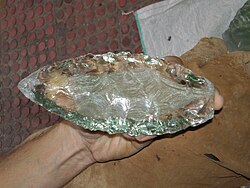
A conchoidal fracture is a break or fracture of a brittle material that does not follow any natural planes of separation. Mindat.org defines conchoidal fracture as follows: "a fracture with smooth, curved surfaces, typically slightly concave, showing concentric undulations resembling the lines of growth of a shell". [1] Materials that break in this way include quartz, chert, flint, quartzite, jasper, and other fine-grained or amorphous materials with a composition of pure silica, such as obsidian and window glass, as well as a few metals, such as solid gallium.
Contents
Crystalline materials such as quartz also exhibit conchoidal fractures when they lack a cleavage plane and do not break along a plane parallel to their crystalline faces. Hence, a conchoidal or uneven fracture is not a specific indication of the amorphous character of a mineral, or a material. Amorphous, cryptocrystalline, and crystalline materials can all present conchoidal fracture when they lack a preferential cleavage plane.
Conchoidal fractures can occur in various materials if they are properly percussed (struck). Cryptocrystalline silica, such as chert, or flint, with this material property were widely sought after, traded, and fashioned into sharp tools in the Stone Age.
Conchoidal fractures often result in a curved breakage surface that resembles the rippling, gradual curves of a mussel shell; the word "conchoid" is derived from the word for this animal (Ancient Greek : κογχοειδήςkonchoeidēs < κόγχηkonchē). [2] [3] A swelling appears at the point of impact called the bulb of percussion. Shock waves emanating outwards from this point leave their mark on the stone as ripples. Other conchoidal features include small fissures emanating from the bulb of percussion.
They are defined in contrast to the faceted fractures often seen in single crystals such as semiconductor wafers and gemstones and to the high-energy ductile fracture surfaces desirable in most structural applications.[ citation needed ]


